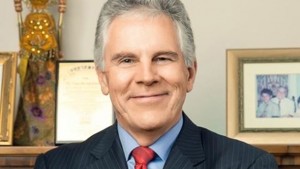Australian complementary health under the spotlight
From ebola to nanotech: Complementary health's newfound confidence

Other stories in this series
Regulatory reform will come, but don’t expect the world to change
You'd have to be a dope not to realise the benefits of hemp's CBD
Industry chief: ‘Once-in-a-lifetime opportunity to slash red tape’
Bashed and beleaguered for years by Big Pharma, Australia’s complementary medicine industry might well be finding its feet once again, yet more must still be done to push its agenda.
That’s the opinion of Professor Ian Brighthope, who as president of the Complementary Healthcare Council (now Complementary Medicines Australia) at the turn of this century, oversaw the industry at one of its lowest times.
“We have fantastics products, perhaps the most powerful in terms of the future of healthcare,” Prof. Brighthope said in Sydney last week. “That’s a rather bold statement, but I believe it as a medical practitioner and as a medical academic, and I’ve seen it in my life and in my endeavours to change things.”
Wings clipped
However, if industry actors don’t capitalise on the strength of demand and weight of research, Prof. Brighthope believes they face another 20 years of regulator-driven stagnation.
“In 1989, the Therapeutic Goods Act was enacted [to set out the legal requirements for the import, export, manufacture and supply of therapeutic goods in Australia]. This effectively stopped innovation in our industry.
“Before that, we had an extremely innovative industry. But then businesses shut down, and for another decade no new remedies entered the marketplace. We were absolutely stifled by Big Pharma, which served effectively as the regulator.
Prof. Ian Brighthope was president of the complementary medicine's apex body between 2000 and 2003
“I remember meeting with various politicians all round the country to try to prevent the industry being taken over by the Therapeutic Goods Administration [TGA, the complementary health regulator]. Nothing much has changed since until recently, when we began working more closely with the government and the regulators.”
Addressing members of Complementary Medicines Australia, Prof. Brighthope called on the industry to seize the initiative at a time when the government is looking to slash red tape within the TGA with the aim of allowing Australian complementary companies to bring back innovation.
Profound opportunities
However, there is still a fear that the industry isn’t investing enough time and effort to deliver science-based remedies to the mainstream.
For example, four years ago, when addressing a meeting attended by Dr Rowan Hammett, then the head of the TGA, Australian psychiatric specialist Professor Michael Berk of Deakin University talked about the benefits of N-acetylcysteine in mental illness, and challenged the audience to come up and register it as a product.
“It still hasn’t appeared in the marketplace,” said Prof. Brighthope. “It is a product that can help ADHD, autism spectrum syndrome, manic depression, schizophrenia and so on. It has been proven to be safe and effective in trials carried out in Australia, yet I cannot make it because of the bureaucracy. If it was pre-1989, it could have gone onto the market.
“There are opportunities for us to carry out research in very profound areas. For example, many doctors in Sydney have been carrying out faecal transplants for a long time for serious disorders, and getting very good results.
“One day, you will be diagnosed with a disease, you will be given some bath salts and you will go home and bathe in these salts that are full of probiotics, and your disease may be cured. I can see this happening.”
Controversially, Prof. Brighthope has suggested that doctors in west Africa should be looking to vitamin C as a defence against the current ebola outbreak there.
“If I was asked what would I do to combat the ebola virus, I would tell everybody to improve their diet, do some exercise and take a large dose of vitamin C, because this works for nearly every viral infection,” he said.
“Yet our researchers have not got off their backsides and have done zero studies on this. There are thousands, if not tens of thousands, of anecdotes supporting intravenous vitamin C treatments.
“What happens with fever and haemorrhage? You bleed. What do you see with chronic scurvy? It’s bleeding from the gums, bruising, bleeding from the gut. [Ebola is] just a more severe case of an acute, induced scurvy. Hit it early enough and you might save a few lives, because what kills people is not the virus but the cytokine storm the body reacts with.”
Forgotten in the face of trends
According to Alecia Foster of Comvita, a Brisbane-based natural health company, too many people have lost sight of the benefits of traditional treatments like vitamin C as they look towards pharmaceuticals and fashionable superfoods.
“We have forgotten this,” she told FoodNavigator-Asia. “If you take a chronological perspective, we discovered the benefits of vitamin C when the first fleet arrived in Australia and everyone was dying of scurvy. We found plants that were naturally high in vitamin C and it cured us.
“And then, as societies advance, and other things take up our attention, we just forget. There are so many other treatments vying for our attention, and so many people telling you what’s good for you that you can just forget what’s common sense.”
She adds that olive leaf extract, one of the products Comvita manufactures, has also suffered in this regard like vitamin C.
“It’s been a superfood for a long time but people have just forgotten this after jumping on the bandwagon when the next great thing arrives.
“In actual fact, olive leaf has been found in clinical trials and laboratory studies to be five times greater in greater in antioxidant capacity as vitamin C. That’s proven. I’m not saying it’s a substitute for vitamin C, but it’s a complement.”
Prof. Brighthope believes that treatments like nano silver— an antibacterial technology which uses ionic silver nanoparticles—and stem cell therapy have a place in complementary medicine’s agenda.
“What have we got to do with stem cell therapy? Some time ago I saw an amputated finger, and that amputated finger grew again simply because of the application of nano silver and stem cells.
“And not only did the finger grow back, but the muscles, bone, skin, arteries and veins grew—it even grew a new nail. Nano silver—is that a part of our industry? I don’t know, but if you go into a health food shop, you might find a bottle.”
Change of approach
Over the last year, the industry’s motivation seems to have grown significantly, due in no little part to the a change in direction overseen by the CMA’s chief executive, Carl Gibson.
“The revolution [Prof. Brighthope] always wanted to see is here now,” Gibson told us. “My background in public policy and advocacy has helped us to shape a new direction for the complementary health industry.
“Before, I think we focused heavily on the detail of the regulations, but then when I arrived we began to take stock of the skillsets we now needed. By concentrating on policy, our messages are now resonating with a government that wants to listen.”
There is still much work for the industry to undertake before the complementary health revolution Gibson refers to can be realised to its full potential in terms of innovation as well as achieving equal footing with the pharmaceutical industry, says Brighthope.
“We need education, we need research, we need to do what we did in the past, when we had presentations to politicians in Parliament House; we had dinners, and we even hired the number one committee room to give presentations to politicians.
Some two-thirds of all Australians now use complementary medicines, so there is no question of consumer demand; it is now down to the desire of the industry to make further inroads, he added.
“We need to be more active so we can have a regulatory authority that isn’t dominated by Big Pharma and its Big Pharma mentality.”
- Tomorrow: The regulatory revolution















